My experience at the Notting Hill Carnival was truly unforgettable. I had always heard great things about this event, but I would have never expected to feel so “at home” in London. Anxious and totally in my element, I was ready to tackle the crowds of thousands of people and celebrate my culture. There was sunlight, upbeat music, aromas of spices and charred grills, and a different dance party on every other block- I was in heaven! It didn’t take me too long to realize that this culture didn’t only pertain to me or the people that were recognizably Caribbean, but also the people who’s appearances were far from it. While standing next to an middle aged white man, who had a Red Stripe in hand and belted out more reggae lyrics than I knew, I realized the culture of London was very different than that of New York.

In Brooklyn, New York, there is also a festival held annually to celebrate the culture of the Caribbean that my family and I attend every year. Taking place on Labor Day weekend informally titled “The West Indian Labor Day Parade’, it is a day filled with great music, food, and beautifully embellished costumes- just like the celebration at Notting Hill. (http://www.carnaval.com/cityguides/newyork/ny_carn.htm) Armed policemen are scattered on each block ensuring safety amongst the very homogenous crowd that this carnival attracts. Located in one of the better communities in Brooklyn, populated by a moderate amount of white people, I can count on two hands the amount of white people that I have seen at the carnival in the last couple of years. This is why I was pleasantly surprised at the dynamics of the multitude at Notting Hill. I grant that the inclusion of alcohol could have played a major part in brining so many different people together but, I strongly believe that that couldn’t have possibly been the only commonality between millions of people. I witnessed people actually enjoying themselves; whether it was drinking, standing on outrageously long ques for food, bopping and singing along to the music, and even dancing in the streets. It puts a smile on my face to know that there are people other than Caribbeans that have a keen interest in our culture; something that I haven’t seen in New York, or in any of the US thus far.

Despite taking forty-five minutes to escape the crowds and find an operating train station, I had a delightful time. Seeing people of all different races, cultures and ages come together and enjoy eachother’s company was like a breath of fresh air, and gave me some type of hope for humanity- even if there were one too many Rum Punches involved!
Tags: 2010 Melissa · Uncategorized
The Notting Hill Carnival was not what I expected, but at the same time did meet some of my expectations. The ones it met: the drinking/party atmosphere (it also exceeded this one by a lot) and excellent food. The parade disappointed me; I was expecting more cultural representation and differentiation. Instead, I found it to be lacking. My initial reaction was, “Okay. This is different, but cool.” By the third “float,” however, I found them to redundant. The costumes were gorgeous, but some of the marchers should have rethought their costume decisions. Coming from a family that loves parades- we watch every Thanksgiving Day & Rose Bowl parade together- I was expecting different floats, all intricately designed and reflective of the culture of the community who put that float together. Instead, it was mostly people in sequined and glittery costumes walking behind a big truck (or double decker bus) that was playing loud music- some of which was American. I was hoping for a cultural learning experience, not a chaotic drinking party in the middle of the day posing as a cultural experience. Setting aside the drunkard-dodging and remixed American music, I enjoyed the carnival for the experience it offered; it was definitely a chance to observe the English in what Fox referred to as a “liminal” space. In different ways, I felt that people were more relaxed and open to just enjoying the experience. The typical English reserve seemed to be greatly diminished (among the sober and definitely not sober). It was a great overall experience, but I don’t think I would go to the Carnival in the future.
-
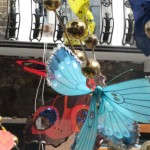
-
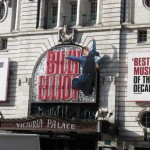
Billy Elliot, however, exceeded all of my expectations. It is something I wanted to see while I was here, but I never expected it to tie Wicked for my favourite musical. (Note: I’m a bit obsessed with Wicked. You probably don’t want to mention it in a 10 foot radius of me if you don’t want to get into a lengthy discussion.) About a young boy who discovers that he is a talented dancer and decides he wants to dance for life, the story concentrates on several of the topics we have (or will) discuss will discuss in class, including labor strikes, class, and the government. Throughout the entire musical, class is an issue. For the miners in Billy’s community, dancing isn’t something done. A male dancer is a “poof” not to be taken seriously. A career as a miner and providing a steady income for one’s family is the most respectable option. Billy’s dad is dead set against Billy dancing, but when he realizes he is so talented and can’t help but dance, he decides to go back to work in the mines. (They’ve been in the middle of a mining strike.) Breaking the strike drives a wedge between him and his older son, Tony. The representation of community in the musical, especially among the miners despite their hardship, is an excellent example of the way our readings have mentioned communities coming together. Furthermore, seeing this community on throughout their strike adds a human dimension that our readings could not express. It brought the stats to life for me, which is something that I normally look to art to do. The musical also touches on Thatcher’s government & the way that it reacted to the strike to break it. (“Merry Christmas Maggie Thatcher” had to be one of the most hilarious and poignant scenes in the entire musical, giving an excellent representation of how elitist that government seemed.) I could go on forever on the way that it relates to class. It’s an excellent musical that I think everyone should see. There is something for everyone in it, especially as we all consider the diversity of London, the struggles of labor, and the English class system.
Tags: 2010 Stephenie
August 30th, 2010 · 1 Comment
Today I saw two very, very different sides of “Britishness,” one at the Notting Hill Carnival and the other at a West End performance of Billy Elliot. I was under the impression that the Notting Hill Carnival was supposed to celebrate the West Indian cultural heritage of the immigrants who came to the Notting Hill area in the 1960s and onward, but barr a lot of flags and glitter, I sort of missed the cultural celebration part. I got the celebration, definitely, but I was expecting much more emphasis on West Indian music, crafts, etc… Instead I heard a lot of American rap, dodged a lot of people drinking, and saw too many people wearing spandex and feathers who should really have rethought the spandex. Really, really rethought the spandex. Don’t get me wrong–the costumes in the parade were absolutely stunning, and the food was fantastic. It just seemed as if culture was put on the backburner so that drinking and partying could dominate the day. Kind of like Saint Patrick’s Day in America–a bunch of people dig up their Irish heritage (or fake their Irish heritage) in order to drink more for the day. Definitely very interesting to see, but kind of disappointing as a cultural learning experience.
Directly after leaving the carnival, however (which took some fancy navigating), I went into the West End to see Billy Elliot, which was so many types of amazing. As I was watching the show, I was struck by what a different type of cultural celebration it was–it concentrated exclusively on British working-class culture, particularly in Northern England. Stephenie, Matt, and I were talking during intermission about how much we could tie our readings into the show’s themes, and also about how we were really enjoying seeing a show that was so “British.” Lee Hall, who wrote the screenplay for the film with Jamie Bell and then adapted it to the stage, had a piece in the program in which he talked about how creating a show that was true to the working-class culture that he came from. We’ve concentrated a great deal on immigrant populations to England, which is definitely an important and dynamic topic, but we haven’t really addressed white British culture too much. Billy Elliot centers around the coal miners’ strike during the Thatcher era and, allowing for theatrical exaggeration, is a really interesting look into the lives of working-class families in that situation. Some of the themes presented in the play really resonate with our readings, as well. Billy, a twelve year-old boy, wants to break with the family tradition of coal mining by going to ballet school, so his family has to learn to cope with his aspirations. His older brother spends an entire scene talking about keeping the family together and how hard it is to uphold family values in the face of economic desparity and change, which somewhat mirrors the immigrant experience. It’s a different look at what was happening in England during the 1980s, and I found it really interesting. It opened up the picture of British identity a bit more. And the music and choreography were stunning. I think that I overused the word “fabulous” by quite a bit. Yes, it’s touristy, but it’s an amazing show and could also be used as an interesting counterpoint to our discussions of immigration. Just be prepared to be singing the songs for a few days afterward.
Tags: 2010 Holly · Theatre · Uncategorized


What a difference four days makes! After walking the same streets around Notting Hill Station with relative ease during the first day of our program, I found myself attempting to move among hoards of people making their way to the Notting Hill Carnival. Above this text, you should see a side-by-side of the same street on the two different days, and hopefully you can see the incredible difference in the atmosphere. Not only were the streets much more crowded, but they were populated quite differently. While I found almost exclusively older, upper-class Caucasians on my first trip to the area, today I found a young crowd of great racial and economic diversity. Those that currently live here (and, apparently, have only moved here recently in what has become a gentrification of the area) seemed to not exactly gel with the carnival. One of the first things I noticed walking to the carnival was how many buildings were boarded up, just for the weekend. All of these boards, and I mean all of them, were already covered with graffiti (and they could not have been up for more than 3 days). I wonder if this graffiti was a sign of animosity between the carnival-goers and the new, wealthier, inhabitants of Notting Hill.

The Carnival itself was influenced by Afro-Caribbean culture. From the jerk-chicken stands to the booming reggae music, one could easily see this influence. Having visited a market in a Caribbean neighborhood earlier in the week, I found the differences in the atmosphere between the two quite interesting. The slow, charming pace of the market was completely different from the sensory overload on display at the Carnival. People were yelling, pushing, blowing vuvuzuelas, and partying to their hearts content. There was no discernable pattern to what was going on; it was just 3 square miles of chaos. Trash lined the streets (has anyone else noticed the overall lack of trash bins in London?) while signs of drugs were everywhere. While the music, food, and floats were certainly a sign of Afro-Caribbean culture, I felt, from my vantage point, that many in attendance were simply there to mindlessly, and dangerously, party.

According to the website for the carnival (http://www.thenottinghillcarnival.com/history.html) , the festivities originated as a celebration of Caribbean culture, and was rooted in Trinidadian celebrations over the abolition of slavery. While this was originally intended as a moment of unity for Caribbean immigrants, what I saw today felt more like a big London block party that happened to feature Caribbean entertainment and food. Many of those involved in the parade likely knew the history and gravity of the Carnival, but those in attendance did not seem to be there for either a cultural experience or for the original unity that the Carnival intended to be about. I am not suggesting one way of looking at the Notting Hill Carnival is necessarily better. One can be there to revel in the history and culture, or one can be there to party (within reason, in my opinion). It is just interesting to me that there appears to be a shift in perspective of the event over the forty years since it began.
Tags: 2010 Andrew
The Notting Hill Carnival was amazing; done. The smells were what did me. The blend of jerk chicken, sweat, and cannabis were overwhelmingly wonderful; a symphony for the nostrils. Each note sliding through your mind yet blending harmoniously. Needless to say, coming at 930 was not necessary at all, but it quickly picked up in volume and entertainment. The scantilyclad women didn’t grab my time or attention as much as it seems others did, and I didn’t really even check out of the parade that much. What I did love was the competing food stands and street dancing. Each stand seemed to be family owned and operated, which is something I’m seeing more and more of in England. It is also something that I didn’t see a lot of in America. Back to the Carnival. I am still on the fence about one thing though: the overbearing shroud of alcohol. Many of the parade groups had very overt sponsorship from alcohol companies, and it seemed like they were trying desperately to get people drunk.
Then there was the play. Everyone looked so wonderful, and it was so great to get dressed up. Then we got to the Theatre. The seats were tiny and there were tons of people wearing jeans. I will be the first to admit that plays often mean nap time for Andrew. But I’ve really liked the two shows we’ve seen and stayed awake for both of them (the globe was a tricky one to fall asleep in). Arcadia was really cool. The story was ok, but I really liked the execution. The lighting changes and the minimalist scenery also tied things together well. I really liked the scene where the two time periods overlap at the end, neat effect to do on stage. The concept of historians getting something completely wrong because they are looking to become famous is a message that is often times downplayed. We are lost in the pursuit of knowledge, allowing ambition and hope to guide us where discretion should. But then again, that’s the trick about history: unless there are direct records, it’s all just speculation. And no matter how much research you attain, you can never get rid of you bias. Anthropology and Archeology are more slaves to this than other humanities. We look at a few sherds of pottery, and we “know” quite a bit about the culture but too often we forget the interpersonal stories.
The stark contrast between the theatre we saw Arcadia in and the Globe theatre is aparent the moment you step into each. The Globe is as some many have already said was quite “Disney” but you know what? I liked it. The open air and the huddling together– it worked really well, and it helped to blend the worlds of reality and play together. On the other hand, Arcadia’s theatre kept you firmly planted in your world. The boxed theatre and cramped seating as well as the drastic lightings were firm reminders of the wall between the actors and viewers.
Tags: Andrew R
September 2nd, 2009 · 1 Comment
Author’s Note: This post was written and live by yesterday at 2:45 PM. Due to systems maintenance back at Dickinson where the servers are, it was mysteriously deleted and all traces ceased to exist on the Internet. Fortunately I managed to find a partial backup of the post with Firefox’s super clutch about:cache utility. Panic attack over.
Okay, so I was the only one who opted out of going to the backstage tour of the National Theatre. Bad call Andrew, bad call. So while I depressively sit in my room waiting for the group to return, I might as well write one big über-post reflecting on the last week or so here in Britain.
To go back a few days, after Stonehenge, we schlepped out to Bath. I experienced some major mixed fellings on the way there. A knowledgeable friend told me that if there is one place to see in the UK, it is Bath. However, it’s a city whose economy is completely reliant on tourism, and I hate tourist traps. The city itself is a sight to be seen. The architecture stands out most clearly, as almost every building within the city limits is built in the Georgian style of the 18th and 19th Centuries.

http://en.wikipedia.org/wiki/Bath,_Somerset
The first landmark we encountered was Bath Abbey, a picturesque Gothic cathedral from the 7th Century. I stood outside and stared at the exterior for a good ten minutes before entering. It is enchanting, imposing, captivating, and just about any other adjective of the sore fathomable. With that in mind, I was thrilled to go inside. The interior was the mixed feelings I had earlier incarnate. The nave itself is gorgeous, featuring high, vaulted ceilings and intricate stained glass windows reminiscent of Westminster. Juxtaposing the ancient architecture, however, were LCD monitors, postcard stands, and any other touristy accoutrement you can imagine. That made me physically sick to the stomach. It is one thing to have a gift shop attached to historical sites, as long as they are distinctly separated. There is nothing wrong with a tourism economy. But just as the Church and the State should be mutually exclusive, so should the site and the shop. A message to the tourism bureau of Bath: NEVER SHIT WHERE YOU EAT. It is not only offensive to the historical purity of the building, but downright sacrilegious to so blatantly mix shopping with as place as important as Bath abbey.
On a related note, The Tower of London wasn’t any better. Maybe we just chose the worst possible time to visit, but it was absolutely stuffed to the gills with sightseers. We forewent seeing the illustrious crown jewels because the queue was longer than the line for Splash Mountain in Disney World. And I’m sure the main attraction isn’t nearly as exciting. To be entirely honest, I didn’t learn much during my time at the Tower. I know that it is very rich historically, serving as a fortress, a prison, a headquarters, and most recently, a kitschy tourist trap. The most best aspect were the enormous ravens hanging out all over the grounds. They made entertaining noises. Not worth the money. (I took the following photographs.)


CAWWW!
Phew. Ranting is cathartic.
Also, I am attempting to embed a slideshow of Bath Abbey into this post, but am failing miserably. I am giving up and posting a link to a slide.com slideshow instead. Click here to view.
Moving on, yesterday was the world famous Notting Hill Carnival, the second largest street festival on the planet. To give the reader a perspective, imagine a crowded rock concert, complete with all the four essential, ubiquitous smells: food, beer, body odor, and ganja. Now take that crowd and spread it out over a twenty square mile radius, but don’t bother thinning out the population density. This year’s attendance figures aren’t live yet, but in past years the event has attracted an upwards of 1.5 million people split over two days, most on Monday, the main event. Since everything else is closed due to the national bank holiday, about an eighth of London’s population has nothing better to do, so why not get a taste of Afro-Caribbean culture and go to Carnival? (When reading, make sure to roll the R in Carnival for dramatic effect). Everywhere I went was in earshot of calypso, reggae, soca, or any other Caribbean-centric music played at rock concert decibel levels. There were more jerk chicken booths than Starbucks in Manhattan. Red Stripe and Corona quenched the throats of everyone, from the lavishly dressed parade people to the pasty white 20-somethings who can’t dance, in attendance just to escape the vanilla routine of Western life (i.e. me). It is definitely worth seeing, but make sure you arrive in the afternoon. We made the mistake of getting there at 10 AM, and were bored for about two hours.
Slideshow attempt #2
On a completely unrelated note, I have been listening to a lot of jazz lately, namely good hard-bop from the early 70s. I listen to a lot of music and it is by far one of my favorite genres, especially when seen live. As a result, I’ve been craving some raw, live jazz, and what better place to experience it than in the cultural center of the UK. I’ve also been considering writing my research paper on the London jazz scene, so it’s probably a good idea to get out there and experience it first hand. My rabid Googling has pointed me to a place called the 606 Club (click the link to see where the club got it’s name). The reviews are pretty glamorous (“London’s best music venue”), so I’m very excited to go in for a cocktail and listen to some great improvisational jazz, or whatever they have playing that evening. If you have never seen good jazz played in person, trust me on this one and come along to see the show. It is truly the best kind of live music around. Skilled musicians can emanate such powerful emotion from their horns, basses, drums, or voices unheard of in rock, hip-hop, or anything else kids today listen to. Definitely worth the £10 or so cover.
That about does it for now. I’m gonna get back to drinking wine alone in my underwear.
Tags: Andrew B
When I was first told about the Notting Hill Carnival, I have to say I was quite excited about getting the opportunity to attend. However, I really had no idea what to expect. I was told it was the second biggest street festival in Europe, so naturally I thought it would be intense. When we arrived in the morning it seemed pretty dead. The rubbish in the streets told me the prior day must have been quite a good time. I am glad that one of my first discoveries was a 2 litre bottle of Strongbow cider; something I did not expect to see at all. Nonetheless, my initial reaction was one of disappointment. We just walked about looking for a place to sit in order to watch the inevitable parades.
Despite the disappointing morning, the carnival came to life as noon approached. The first thing we saw was a very diverse parade. The participants ranged from a person dressed in what appeared to be a wedding dress with attached skeletons and machine guns to dinosaurs, a snake/bird creature and Corona girls. It appeared like everyone was having a good time, but I was still expecting more people. Luckily, the crowds did begin to grow once we started walking around the neighborhood.
One aspect of the carnival which really interested me was the political graffiti. It seemed that almost all of it, from what I saw, was “leftist” in nature. Two in particular caught my eye. One was a banner of sorts with Che Guevara in the middle. Spray painted on the red background was “Who the f*ck is this” with the response “Surely not Che?” I thought this was very interesting and entertaining. The other piece of graffiti I enjoyed was just a quote spray painted on wood which said “In a democracy dissent is an act of faith.” Overall, I am glad I was able to spot the graffiti I did see and be able to capture it through a lens before it was washed away.
-
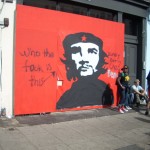
-
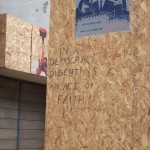
In the end, I really liked what I saw of the carnival. The food was simply amazing and very numerous. It was hard not to walk five feet and not spell something delicious being cooked. The parades were also fun to watch, especially the Jamaican one. Nevertheless, I still did expect more people. Though the crowds were pretty big, for the second largest street festival in Europe, I was disappointed at the amount of people. Of course, that does not mean I would not come back because it was an amazing experience and one I do not regret.
Tags: Andrew F
I am a law-abiding citizen. Sure, I tend to drive five miles per hour or so over the speed limit and I’ll sometimes go through a light that might be more orange than yellow but, overall, I like to think of myself as one who is in good standing with the law. Apparently, I have a lot to learn if this good relationship is going to be kept up in London. Well, my relationship with the police force here is still as strong as ever but the same cannot be said for the mall security personnel here. At the Notting Hill Carnival this weekend, Constable Bird and I chatted for a good amount of time in a very pleasant manner while waiting for the parade to start. Today at a busy Forever 21-like store, I was unable to have a similar pleasant exchange with a grumpy security man who was an active participant in the elbow throwing that was required to get through the hustle and bustle there rather than a guide in helping calm said hustle and bustle. Again, I am a law-abiding citizen. My familiarity with authority figures is pretty low. These radically different run-ins with such figures in the middle of our stay in London coincides beautifully with our reading of Caldwell’s “After Londonistan”. Well-planned, Professor Qualls. But truly, these situations and the reading together make me wonder about the law-enforcement in London. Constable Bird said something that keeps ringing in my ears: “Do people hate the police in America as much as they do here? Everyone likes to jump to conclusions about us without hearing the whole story or understanding the situation.” Well, I still might not know exactly why the security man was so angered by my misplacing a sweater on the wrong rack, but allow me to try to reason through how that situation might tie in to the relationship between civilian and authority figure that is present in London.
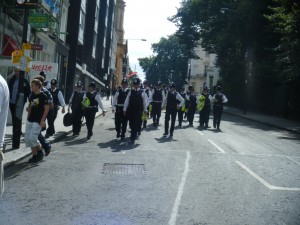
Just a part of the swarm of police coming down the hill
Notting Hill Carnival was packed. There were truly hundreds of people swarming in every direction around the community. A parade full of loud and vibrantly dressed people didn’t help in bringing any sense of order to the streets. I’ve never before witnessed such life and excitement in one area. I loved it. That vibrancy would have been tainted immensely if any unruliness (at a level above shrieking whistles being blown repeatedly for hours) broke out. To ensure this didn’t happen, the London police made sure to come down in full uniform, some on horseback. My first impression of them was one of intimidation. A mass of black and white, the police came down to the parade from on top of a hill, spread out in a way that made sure they took up the entire width of the street. Impressive and something that sent the message: don’t mess with us. After taking a few pictures, I mentally noted the message and continued to anxiously wait for the parade to begin. The police took their places as the barrier between the crowd and the parade; yes, the police were the barrier rather than a fence-like object. It was in this moment that Constable Bird and I met. We chatted about his rather snazzy uniform (the hats are particularly wonderful) and then settled on a more important matter. He complained that the police in London have a reputation of being the hot-headed, rash, and sometimes cruel enforcer figure that the press just loves to slam for any seeming mishap. This was not my experience with London’s finest at all. An officer on horseback allowed a curious and hopeful young boy to pet his horse while Constable Bird chatted about his hat, retirement preferences, and favorite spots in Notting Hill with a curious tourist. He even took a picture with us. A cruel or ticket-hungry description could not be further from the one I would give to Constable Bird and the police force that day. Intimidating, yes; unjust, no.
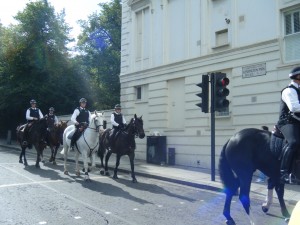
The store I visited today was packed as well. With sweaters for two pounds, it’s not a mystery why. Again, I was a bit intimidated by the security personnel there. They wore all black and were positioned at almost every clothing rack. Searching for your size while someone is scrutinizing your every move is less than calming (and size is also a very personal matter so not only are you not calm, you’re also a bit embarrassed and/or annoyed. Unfortunately, I was all three- not calm, annoyed, and trying to avoid embarrassment). I put down one of the sweaters on top of a clothing rack when I found a rain jacket I wanted to try on. I had literally just sat the sweater down when this man very harshly demanded to know if that was my item. When he found out that it was, he informed me that I was not allowed to place my item up there. Let’s set up the mental image here. I have a huge purse in between my legs, I’m wobbling as to not run into people, and I’m trying to figure out the size conversion in my head. I’m a bit of a mess. In one of my not-so-bright moments, I look around the store and ask the man where he suggests I put the item in question. He didn’t appreciate that question. Rather than answer me and try to make the situation better, he proceeded to stare me down. He just stared at me. Taking the hint, I hung the jacket back in its proper place, gathered my things, and went on my way (only after running into a person in my efforts). Yes, the situation was a tense one and I was less than polite but I don’t think my reaction deserved such a harsh reaction. While the police at the carnival actually did what they were meant to do (keep the carnival calm and running smoothly), the security man did just the opposite in scrutinizing something incredibly trivial and then refusing to offer any solution to the problem he created in the first place. What is interesting to me is the fact that of these two men, if they walked into a pub in their work attire, Londoners would probably prefer the security man’s presence over the officer’s (at least based on my understanding of the police/citizen relationship here).
Caldwell seems to make the point that London’s law-enforcement is often times rash, not well-thought out, and sometimes quite unjust. Now, Caldwell isn’t focusing on how the law treats college-aged tourists, I understand. Still, my limited exposure to the police in the area makes me believe that the law here strives towards not only fairness and equality but also ensuring the safety of the community. Balancing these is an incredibly difficult task especially in more intense situations than a street fair. But does the security man’s attitude not tell us something of the everyday person’s dealings with authority? In my totally biased opinion, it seems that those who are trying to keep the peace in London are truly trying to do just that. Still, clearly there are those who nitpick at things for reasons of lesser credibility than the greater good (I’m sorry but my sweater was truly not in anyone’s way!). I’m interested which authority figure type is more prevalent in the city: Constable Bird or angry security man. Is London a city under the protection of those who are hoping to keep the peace or under the rule enforcement of those who follow the letter of the law rather than its spirit? I’m not sure but I’m interested in figuring it out…
Tags: Audrey
September 1st, 2009 · 9 Comments
Since I’ve studied Italian for five years, hearing that we had to attend an Afro-Caribbean version of Carnevale caused me to instantly form a few preconceptions. I mistakenly thought that they would be similar; the parade’s commencement immediately smashed this idea. I’ve never seen a gathering so crowded and openly risqué. The sheer number of people was staggering to me, as were the number of food options. I could barely keep up with all that I saw as I was walking, and I enjoyed taking in the smells, sounds, and culture in general.
One thing that irked me, however, was the role of the women in the parade. Scantily clad and dancing in high heels, they wore a full face of makeup and clearly had put a lot of effort into their appearance. They all strutted down the street confidently and didn’t mind posing for pictures. I can’t decide whether I think they were liberated or confined by their role in the parade.
On the one hand, these women line up almost exactly to societal standards of sexuality. Their unnatural appearances reminded me of magazine ads: airbrushed, changed, and deliberate. They literally covered only the barest necessities of their bodies, and there is no doubt in my mind that they were sexualized, both by the parade in general and the infinite number of gazes upon them. Everything from the way that they looked to the way that they moved exuded sensuality.
However, they were entirely unbothered by it. Perhaps their ability to flaunt their bodies in such a way was actually a form of liberation. Some of the women were far from the stick-thin models we are pressured to look like, yet they still flaunted their assets, no pun intended. The fact that they were able to put society’s standards for women (which are normally at least somewhat hidden) completely on display was very interesting. None of them showed the slightest glimpse of shame or regret for their actions, and their confidence was almost inspiring.
I think their role in the parade can be seen as a release, but I’m curious to hear what others thought.

Tags: Amy
-
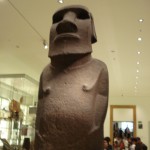
-
Part of the African Exhibit in the British Museum
-

-
Hyde Park Waterfront
-

-
Regents Park
-
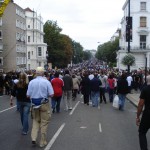
-
Walking towards the Notting Hill Carnival
-

-
Flowers in Regents Park
-
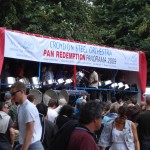
-
Steel Drum Ensemble in Hyde Park
After a busy few days nothing could be more relaxing than a day spent in a park…well two actually. In the morning we started out the day with a class in beautiful Regent’s Park located just a few minutes away from the Arran House. Our classroom discussion centered on two very different topics; Virginia Woolf’s Mrs. Dalloway and “the Blitz”. Despite the difference in subject material both conversations brought up some interesting points and I found myself seeing new perspectives on a lot of things both from my peers and from Professor Qualls.
Maybe it was just the time of day (early on a Saturday morning) but Regent’s Park had a very quiet, quaint feel to it. I realize there is still much of the park that I need to explore but from what I saw with the beautiful flower gardens and shrubbery and wide pathways it seems like it would be a great place to go for a run or relax with a book.
After a great lunch at an affordable mediterranean sandwich place with the three Andrew’s I headed out with Alli, Sarah, Mara and Kim to continue the preliminary work for our group project. We headed to Hyde Park, a place we knew would occupy most of our afternoon. Hyde Park immediately reminded me of Central Park more than any other green space I had visited in London thus far. We decided to wander towards the long expanse of water known as “the serpentine” running through the middle of the park. Along the way we passed a large group of people playing steel drums and moving to the music. The park felt alive and it was the first green space that I felt like was being utilized for large group purposes.
The water was filled with waterfowl of all shapes and sizes. There were ducks, swans and geese just to name a few. We saw that there were opportunities to rent boats for seven quid and we thought it would be a great idea to come back and do that another time. After crossing a bridge we came upon a Peter Pan statue. This was a perfect group photo op. After sitting down and taking in the scenery for a bit we headed back to the park exit content with our decision to choose Hyde as the basis for our group’s walking tour.
Sunday was another busy day. Aidan, Brandon and I headed to the British Museum where we attempted to get through the whole thing. This did not happen. We did end up getting through the Middle East, Greek, Roman, African and North American exhibits however. All in all not bad for one day. We also viewed a special exhibit the museum was featuring about living and dying. This certainly defied the plain yet effective pattern the British Museum has going for it. In one section of this exhibit there was a woman and a man featured. There was a long tapestry made out of all of the pills these two people took throughout their lifetime. Everything from vitamins to birth control to painkillers for arthritis were featured in this amazing display. There was also a display done on how different cultures around the world react to life and death and even how they bury their dead. Not only was this a fascinating exhibit but it added a whole new wrinkle to the British Museum.
After a quick break Brandon, Aidan and I decided it would be interesting to head over to Notting Hill where the annual Notting Hill Carnival was taking place. We had been warned multiple times to bring only the bare minimum and be extremely careful with our belongings. We had also been warned about the huge crowds and lack of personal space we would encounter. Unfortunately for us nothing could have prepared us for what we saw once we got off of the Notting Hill tube stop. Endless masses of humanity were walking. We had no idea where their final destination was so we simply followed. Eventually the street opened up and even more people appeared. There were floats making their way down the streets, loud music blasting and people dancing and singing. It was unlike anything I had ever seen before. People that lived in the area were charging others money to use their bathroom. There were no trash cans so litter was piling up in the streets. Other folks were walking around with coolers of beer and soda in an attempt to make a little money. Although large crowds are not my thing and I do enjoy my personal space going to the carnival was an eye opening experience. As Americans sometimes we are so driven to achieve a certain goal, meet a certain deadline, fulfill a certain quota. There has to be some sort of end reward for everything. The nice thing about the Carnival and the thing that I struggled to understand the most is that there was really no point to it. Each and every person made their experience what they wanted it to be. Some used it to express their cultural heritage, some used it as an excuse to hang out with friends or family and some simply used it to get drunk. The bottom line was that everyone was there and having a good time in their own right.
After navigating our way through masses of people we veered off the main path a little bit and found a street with some places that looked like they would be good to eat at. After completing our meals we decided we should start finding a way out of the carnival knowing that it would take us a very long time to navigate out of the crowd. For a while it seemed that no matter where we walked there were people in every direction with no apparent end in sight. Finally we approached a street corner and across the street there was traffic, the first sign that the festival had an end. We attempted to navigate our way to Paddington Station but after a decent walk opted to take the bus to Great Portland Street instead and walked back from there. The entire journey took less time than I thought it would and we were back at the Arran House by a little after 6.
As I continue to explore here I feel like I am getting a better sense of all the different expressions London has to offer. I’ve seen it’s artsy side, it’s serious side, it’s fun side and it’s theatrical side. What will I find next?
Tags: Henry · Museums






















